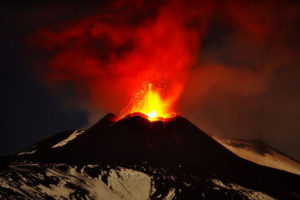
Mt. Etna, Europe’s most active volcano, spews lave during an eruption on Nov. 16, 2013. The cold summer of 1816 is attributed to large volcanic eruptions. (Photo credit: Associated Press)
The summer of 1816 is known as the year without a summer in eastern North America.
While extensive weather observations were not available, people’s journals documented the cold weather. Snow fell on June 5 in Vermont with temperatures in the low 30s, following a day with high temperatures in the upper 80s.
After the early June cold spell, farmers replanted as temperatures returned to normal. Another cold spell hit in July with freezing temperatures. Frost was also observed in August.
Weather in Europe and other regions of the globe was also abnormal as unusually cold and wet weather contributed to failed harvests.
The cold summer is attributed to large volcanic eruptions. Between 1812 and 1817 there were three major eruptions. The largest was Mt. Tambora, which erupted in Indonesia in April 1815.
The violent eruption pumped large amounts of debris and gases into the stratosphere. It took about a year for material from the eruption to spread globally. This cooled the planet because the tiny sulfuric acid drops reflected energy from the sun back out to space.
Not everything surrounding this event led to bad news. A group of friends vacationing in Switzerland found the cold summer unfavorable for outdoor activities, so they decided to have a ghost story contest. The winner was Mary Shelley and her story was published in 1818 — “Frankenstein.”

